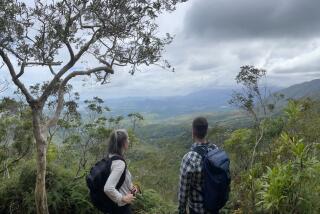Sex, gluttony and hoarding marked evolution of flowering plants
- Share via
Never mind the selfish gene – the cellular family history of the oldest living species of flowering plants is marked by enough sex and gluttony to earn a place in Shakespeare’s folio.
The powerhouse organelles inside cells of Amborella trichopoda, a woody shrub that grows only in the humid jungles of New Caledonia in the South Pacific, gobbled up and retained the entire genome from the equivalent organelles of four different species, three of algae and one of moss, according to a study of the plant’s mitochondrial DNA published this week in the journal Science.
The results are the product of a years-long effort to sequence the full genome of the plant, a crucial step in solving what Charles Darwin once called “the abominable mystery” -- the sudden flourishing long ago of several hundred thousand species of flowering plants.
An analysis of the nuclear DNA of the species, published in the same edition of Science, revealed that the plant is the equivalent of the animal kingdom’s duck-billed platypus -- a solitary sister left behind more than 100 million years ago by what became a panoply of flowering, or fruiting, plants.
The genome map, undertaken by the Amborella Genome Project, an international consortium of universities, enabled researchers to infer the genetic makeup of the most recent common ancestor of A. trichopoda and all other flowering plants. It suggested that this ancestor likely evolved after an event that doubled its genome some 200 million years ago. Such an event could help explain what so baffled the father of evolutionary theory, the researchers said.
The map of the genome also serves as a reference point for explaining the evolution of many of the subsequent species that form the backbone of the human food chain.
But enough about nuclear DNA -- let’s get to the sex and gluttony.
Researchers who mapped the genome of the plant’s mitochondria, the organelles that are the energy factories inside cells, were stunned at its size and diversity and by evidence of some intracellular shenanigans unsuitable for prime time.
“We think this paper will help bring mitochondrial sex out of the closet, if you will,” said Jeffrey D. Palmer, an Indiana University evolutionary biologist and senior author of the mitochondrial DNA paper.
“There’s not another genome in any organism of any type like this,” added Palmer. “No one has found this scale of horizontal DNA transfer even in a bacterium, where it’s really common. No one has found whole genomes, much less four of them, taken up by horizontal transfer.”
A somewhat downtrodden bottom-dweller of the South Pacific tropics, A. trichopoda hosts a bevy of algae, moss and other hitchhiking plants, some of them parasitic. In that rough-and-tumble world, tears and wounds likely exposed the plant to foreign mitochondria, which then fused with its own mitochondria -- organelle sex.
“In some real sense we should regard mitochondria to be engaging in a kind of sex, just like nuclear genomes do,” he said.
Meet the animals that fascinated scientists in 2013 [Photos]
The plant’s mitochondria thus retain a kind of fossil record largely absent in other plant species. The foreign DNA amounts to about six genomes, the researchers believe -- at least four of them acquired in whole.
The foreign mitochondrial DNA also appeared to come only from green algae and land plants, with no evidence of transfer from fungi, which should have had ample opportunity to come in contact with the plant’s mitochondria. That led researchers to conclude that mitochondrial fusion of fungi occurs by a different mechanism than in green plants.
But unlike other plant species, which tend to shed foreign acquisitions over the course of evolution, A. trichopoda retained its interlopers, mostly in a silent form of pseudo-DNA or “junk” DNA. It took on about a million DNA building blocks, swelling to a whopping 3.9 million base pairs. Typical plant mitochondrial genomes contain about 500,000 base pairs.
“An analogous situation to a human mitochondrial genome would be the old lady who swallowed a fly -- and a spider and a cat and a dog and a horse,” Palmer said. “You’d have all those genomes from all those animals sitting inside your own human mitochondrial genome. And the only difference would be: that lady burst. The Amborella genome didn’t burst. It swelled to an enormous size and is just stuck with all this extra DNA. So, hence, it’s a constipated glutton.”
[Corrected Dec. 21, 9:30 p.m.: A previous version of this post cited the journal Nature. The studies were published in Science. It also stated that the mitochondrial genomes of three moss and one algae species were incorporated in the flower’s mitochondrial genome. The species were three algae and one moss.]






